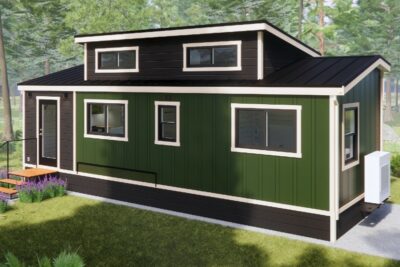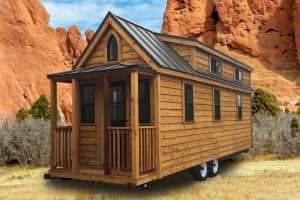How to Insure Your Tiny Home
Get the coverage you need to protect your lifestyle
KEY TAKEAWAYS OF A TINY HOME
- Tiny houses are usually between 100 and 400 square feet.
- You can insure a tiny house, but the type of policy you buy depends on how the house was built and how you use the home.
- It’s a good idea to think about insurance before you build a tiny house, so you know which options you’ll have.
Now What Is Actually A Tiny House?
A tiny house is exactly what it sounds like: a really small house. While there are no official size limits, tiny houses tend to be between 100 and 400 square feet. By comparison, the median size of newly constructed single-family homes in 2020 was 2,333 square feet, according to data from the U.S. Census Bureau.
Tiny houses are either homes on wheels (and, therefore, moveable) or stationary. This distinction—along with how you use the home—determines the type of insurance you need.
RV Insurance for Tiny Houses
RV insurance may be the right choice if your tiny house is on wheels and you plan to move around frequently because it covers your home while it’s parked and during transport. As RV insurance is designed for travelers, it includes provisions that some of the other options don’t—namely, collision coverage.
Basic RV policies typically include these types of coverage:
- Collision—This kicks in if your tiny house is damaged in an accident with an object or another vehicle, regardless of fault.
- Comprehensive—Also known as “other than collision,” this covers events beyond your control, such as theft, vandalism, fire, falling objects, weather-related incidents, and collisions with animals.
- Liability—It helps to pay for property damages and injuries that you cause.
- Uninsured/underinsured motorist—This covers you if your tiny home is hit by someone with no insurance or not enough insurance. It helps pay for damages to your tiny home, personal injuries, and lost wages if you can’t work.
- Personal property—As the name implies, this covers your personal property in the event that it’s lost, damaged, or destroyed.
- Medical payment—This helps cover medical bills for you and your passengers if your tiny house is in an accident.
Not all insurance companies offer the same lineup of coverage options, so review your policy to make sure it provides the coverage you need. If it doesn’t, fill in the gaps with endorsements or a separate policy. For example, if your policy doesn’t cover personal liability, you could get a cheap renter’s insurance policy to cover both your personal property and your personal liability.
Mobile Home Policies for Tiny Houses
If you plan to move your tiny house just a couple of times a year, a mobile (or manufactured) home insurance policy might be your best bet.
A comprehensive mobile home insurance policy is similar to standard homeowners insurance—it covers the home, your personal property, and liability claims. However, unlike RV insurance, mobile home insurance doesn’t cover the home or your belongings while your tiny house is in transport.
For that, you’ll need a transit endorsement. The policy must be in place before you transport your tiny house, which means you must inform your insurance company before you plan to move so it can update your policy.
Another option for mobile home insurance is a named peril policy. These are comparatively inexpensive policies that cover specific causes of loss named in the policy—and nothing else. This means that if your tiny house is damaged by a peril not listed in the policy, the cost of any repairs will come out of your pocket. Thus, while you can save money with a named peril policy, it may not be worth the added risks.
Tiny House Insurance Specialists
We at Bundlers Insurance Brokers have a handful of small companies that offer tiny-house–specific coverage—and that number will likely increase, given the growing popularity of tiny homes in 2023. The companies we have generally offer coverage for any traditional or alternative living structures, including DIY units, off-the-grid cabins, micro homes, storage container homes, park models, custom RVs, and accessory dwelling units (ADUs). As these companies are tiny house–specific, they tend to offer the most options and greatest flexibility. It might take a little back and forth with a representative, but you should be able to get the exact coverage you need for your tiny home.
Do I Need Insurance for My Tiny House?
If you used a mortgage or other loan to finance your tiny house, your lender might require you to buy insurance (the same way lenders do for traditional homes and cars). And if you transport your tiny home, most states require you to have liability coverage—just as for a regular RV. Otherwise, there’s no legal requirement for you to insure your tiny house. Still, a tiny house is a serious investment, so it makes financial sense to protect it with a good insurance policy.
How Much Does Tiny House Insurance Cost?
There’s no set price for tiny house insurance. It depends on numerous factors, including:
- Your tiny home’s construction, size, value, and RVIA/NOAH status
- The value of your personal belongings
- How you plan to use the home (e.g., parked in a tiny house community or on the road 52 weeks a year)
- The coverage you want, including any extras, such as a trip endorsement
- Your claims history
- Your credit history
RV policies generally tend to be more expensive than mobile home insurance because the former protects the home while it’s in transport—which puts the home at a much greater risk than if it were simply parked somewhere. And, of course, the cost also depends on the coverage limits and deductible you choose.
The Bottom Line
Tiny house living isn’t for everyone, but those who embrace it can enjoy benefits such as a lower cost of living, the freedom to move and try out new places, a smaller carbon footprint, and the ability to get off the grid. Just remember to research and buy a good insurance policy to protect your home—and your lifestyle—before you start enjoying your tiny house.


